I realize December isn't quite over yet, but I don't think I'm going to finish another book in the next seven hours. I had kind of an end of the month reading push this month, mostly because we had a week off from work, but also because I was very close to a big number of books read this year and wanted to see if I could meet it. We'll get to that tomorrow, when I talk about the best books I read all year.
Today, though, these are the books I read in December and what I thought about them:
1) Hollow City continues Ranson Riggs' story of Miss Peregrine's Peculiar Children, picking up minutes from where the first book ended. The children, driven out of the protective time loop that shields them from the world, attempt to flee the army of evil chasing them while also trying to find someone to aid their injured protector, Miss Peregrine. Accompanied by Jacob, the boy from present day Florida who joined them in the last book, they find themselves in WWII London, trying to evade bombs and capture at the same time. Unfortunately, things are not what they seem, and at the end of the book they may be in worse trouble than ever. I like the story in these books, but really don't feel anything about the photography, which is supposed to be one of the things that makes them special and wonderful.
2) They have a lot of troubles at the university in The Land-Grant, but they don't seem to have an editor, something that this meandering novel with too many pointless subplots badly needs. There was some brief chatter on campus when it came out, because the author is a professor here and this novel of bureaucratic absurdities in higher education might be about our school (the stadium on the front cover is definitely our football stadium), but really this could be any large public university in the SEC. This book is also a really good example of why I haven't written a book about work when everyone says, "You should write about your job!" This book was barely interesting to me, and I work here. Why would someone outside of work be interested in this at all? There's a discussion I hear whenever a movie like For Your Consideration comes out that the American moviegoing public isn't really all that interested in movies about making movies, but that Hollywood keeps making them because moviemakers like movies about themselves, and I wonder if something similar is going on here, where the only people who got excited about this book did so because it's sort of a book about them.
3) Ransom Riggs concludes the story of Miss Peregrine and her peculiar children with The Library of Souls, a convoluted but fast moving story of sacrifice, betrayal, friendship, and death. Will Jacob and his friends rescue Miss Peregrine and save all of the peculiar children all over the world? Or will Miss Peregrine's evil brother, Caul, kill them all and ascend to power as the ruler of the world? Other than a minor nitpick about someone dying off panel, I enjoyed this. I actually went straight from the last book to this one, but finished a Kindle book on the treadmill in between.
4) I finally go around to reading the last book in VC Andrews' Dollanganger family saga, Secret Brother. At the conclusion of the previous novel, there was a last chapter shocking reveal that the newly rebuilt Foxworth Hall was actually owned and built by elderly, wheelchair-bound Cory! Somehow Cory, the twin who dies in Flowers in the Attic, survived and became rich, unknown to his family, but how? What happened? In "Secret Brother", we are introduced to Clara Sue, a teenager whose little brother, Willie, is hit by a car in the opening pages. Rushing to the hospital, Clara Sue and her grandfather discover that a second little boy the same age as Willie has just been left in the hospital emergency room by an unknown man. This second boy is near death, malnourished, and suffering from arsenic poisoning, and in the aftermath of Willie's death Clara Sue's grandfather begins paying the poisoned boy's expenses, then moves him into their house, and then names him William. Is Clara Sue's grandfather trying to replace the grandson he lost? Will the poisoned boy recover from his amnesia? And will Clara Sue forgive them both for pushing the memory of her brother away?
I have two problems with this:
A) V.C. Andrews already had a character named Clara Sue, Clara Sue Cutler in the "Dawn" series. It's a distinctive combination name, and the editors should have changed it.
B) In "Flowers in the Attic" Corrine informs the children that Cory died on the way to the hospital and was already buried, and that she was the one driving him to the hospital. Later, toward the end of "Petals on the Wind", Cathy doesn't actually say she found Cory's body (at that point it would be skeletal or mummified) in a hidden room in the attic because Corrine cuts her off right when she's building up to it, but that's strongly implied. If we're willing to believe that witnesses at the hospital mistook Corrine for a man when she dumped Cory out of the car (which is possible), and that Corrine somehow had a change of heart and left Cory to receive medical treatment knowing he could recover and destroy her after she'd been poisoning him for months (not likely), there's still the problem of whose body Cathy found in the attic a decade later.
That's a lot of continuity problems for a book that they pushed out to try to milk some of the publicity from the Lifetime series of movies based on the original ones, and on top of that this book wasn't even that good. On the other hand, these couple of paragraphs are probably the deepest intellectual thought that anyone's devoted to V.C. Andrews in several years.
5) My friend Lucy Snyder's newest collection of short stories, While the Black Stars Burn, was interesting and sometimes disturbing. I'd read one of the stories in another collection, but there's a sequel to that story right after it in this book, so reading it again was still interesting since I wouldn't have remembered the character otherwise. There's one story that maybe I shouldn't have read while I was eating, due to some disturbing food-related imagery, but that was still a good story that I just happened to read at the wrong time. Even worse, I was reading it at chili's, and you know how reading there usually works out for me.
6) My friend Leo bought me Hanya Yanagihara's A Little Life for my birthday. It was challenging to read in some places because it resonated with my own life in some ways, but deeply moving. It made me cry on the treadmill twice, so I finally just went on a three hour reading binge to finish it. I'm a little disappointed that I didn't see the main twist coming, but I was so under the spell of the story that the possibility never entered my mind even though I've guess the same thing correctly in movies I've never seen. This was a very absorbing book, and worth the read. It's hard for me to sum up all the things I felt while reading this, but it's still sticking in my head several days after finishing. I'm already thinking about possibly rereading it, but need to give myself a little time before I do.
7) Wayne Gladstone's Notes from the Internet Apocalypse started off as interesting satire. When the entire world suddenly loses the internet, Gladstone wanders a New York City reeling with shock. People physically poke each other in coffeehouses. Gangs of YouTube Zombies surround cats and try to force them to perform tricks. But there's hope: a psychic information dealer named Jeeves has announced that there is an internet messiah, and he will return the internet to the world. The bad news is that the Internet Messiah might be Gladstone, and he has no idea where it is. As quirky as this started out, by the end it dissolved into a mess, and I won't bother with the sequels.
8) During my "cleaning out the bookshelves" project, I came across a copy of Harry G. Frankfurt's On Bullshit, a tiny little book that I forgot I owned but which many people were talking about when it was published in 2005. Ten years later, it isn't really as shocking to see a book on a table in the bookstore with profanity on the cover, but the philosophical discussion of the nature of bullshit and the purpose it serves in our society is still an interesting read.
That's it for December. It may not seem like I had a big reading push, since that's a pretty average number of books for the month (especially with that last one being a novella), but 3 through 8 were all completed in the last eleven days of the month, so that has to count for some kind of effort.
Anyway, come back tomorrow and I'll talk about the best books I read all year, and reveal the year-end total.
Thursday, December 31, 2015
Thursday, December 24, 2015
Christmas Eve with the Super-Heroes
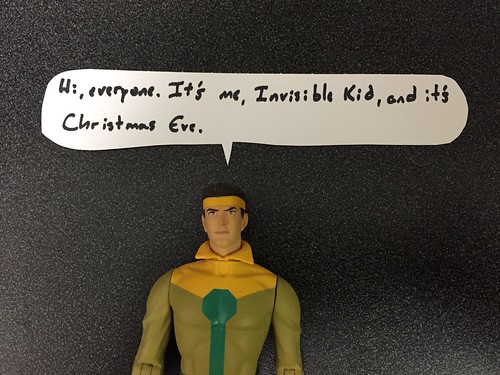
Remember that time that Ferro Lad and I shared a Christmas story of explosions, cloning, and death? Well, in an effort to keep Ferro Lad from continuously asking if we can open the Christmas presents early, I've decided to distract him, with a story of Christmas.
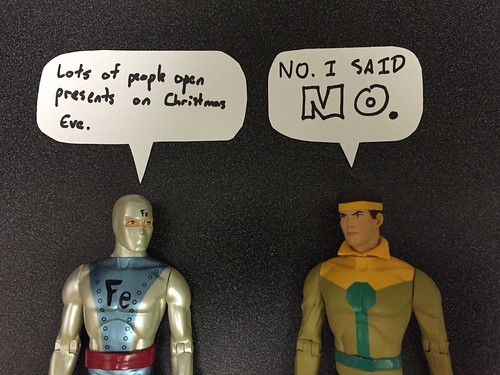

As I was saying, a story of Christmas, starring our friends Superman and, God help us all, Lois Lane. In a rare, shocking twist, Lois actually isn't the worst person in the story.
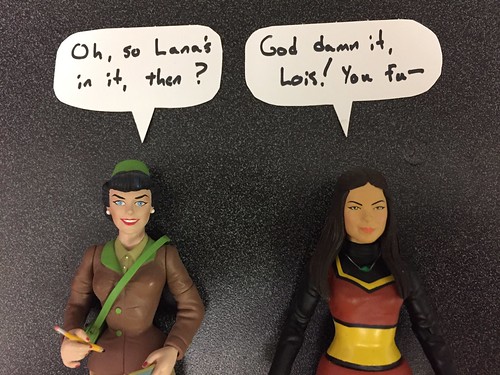
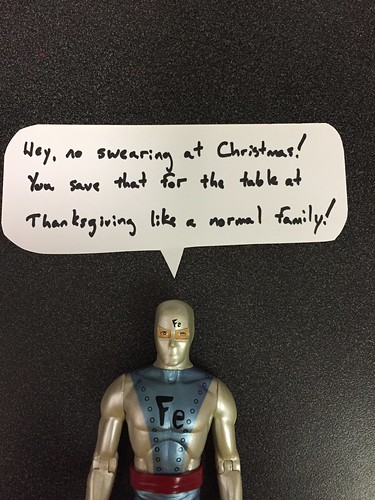

As I was saying, our story comes from the pages of DC Comics' "Christmas with the Super-Heroes", published in late 1974 but cover dated early 1975:
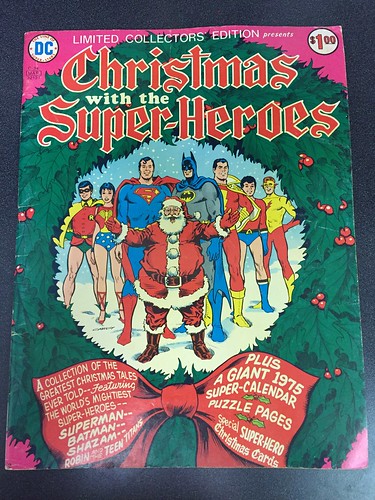
A giant, tabloid-sized comic, it contains charming holiday moments like a man trying to strangle Batman with Christmas decorations:

and Wonder Girl, Wonder Woman's younger sister, beating up some thugs in a junkyard while dressed as Sexy Santa:
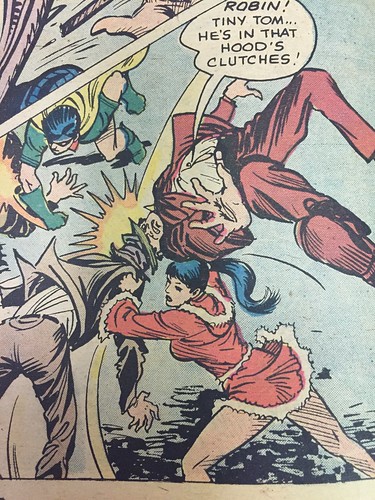
because that's what Christmas is all about. It also contains our story:
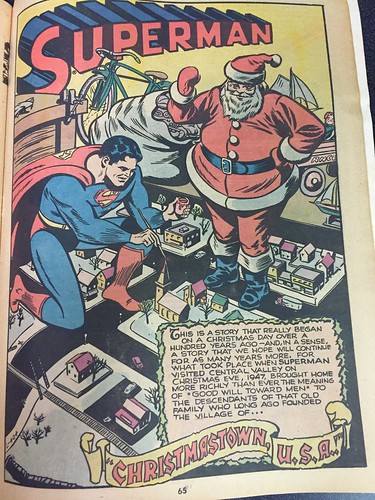
Guessed who the most awful person in the story is yet?
I'll give you a hint: it's not Lois, and it's not Santa.
Our story opens at a tiny, sad train station in Christmastown, USA:
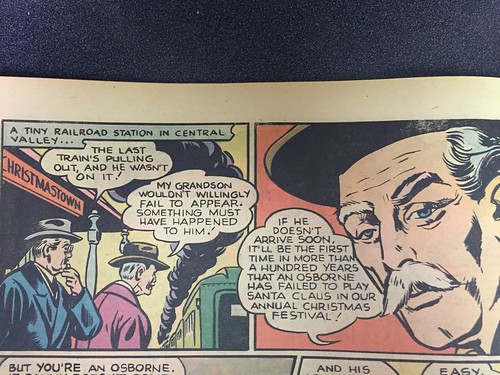
Yes, in keeping with the tone set in the rest of the book, we start with a broken family and a shattered tradition handed down through generations. Things are also about to get worse, as Lois and Clark discover on the way to Christmastown's annual holiday festival:
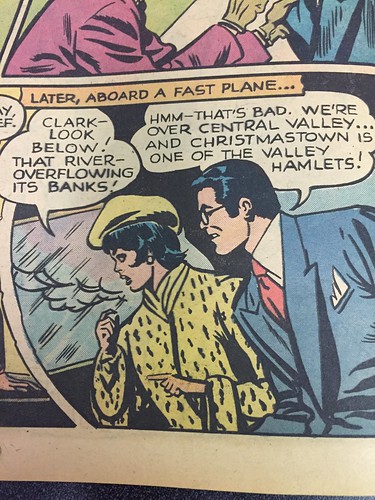

Not only is Christmastown's Santa missing, but they're flooded.
Merry Christmas.
Fortunately Clark Kent is, of course, Superman. Diverting Lois to cover the floods while he covers the holiday festival, Superman flies off to find the mayor of Christmastown and reassure him:
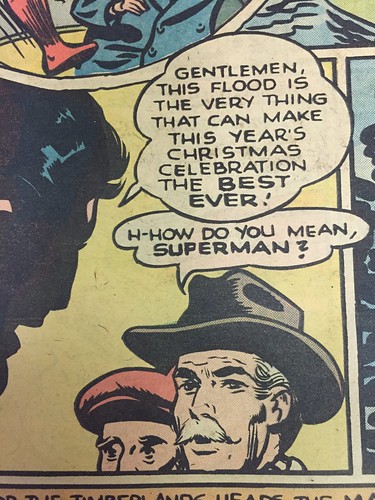
I'm as confused as the mayor. Tell us, Superman, how will the flooding make this the best Christmas ever? Is it because you're going to use your super powers to fix the floods and reverse hundreds of thousands of dollars in property damage? That's why you start cutting down trees, right? To build a super-dam or something?
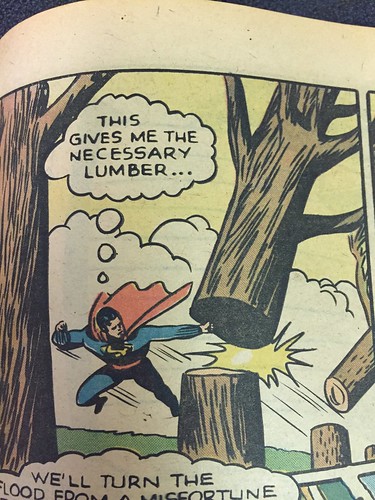
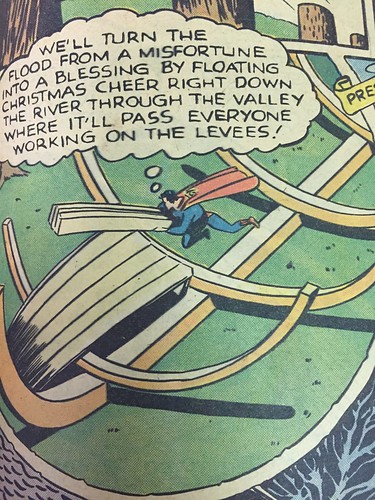
Wait, what?
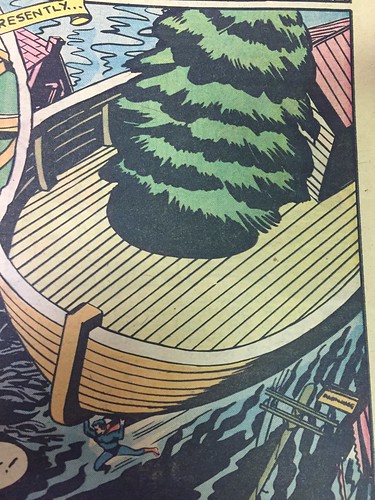
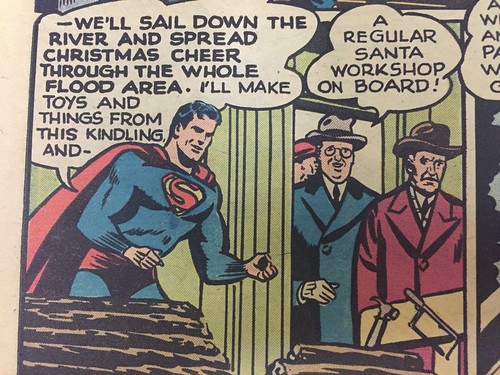
Superman isn't going to do anything to stop the floods. Instead, he's going to build a party barge to float over the ruined livelihoods of the citizens of Christmastown as they struggle to shore up the levees that will prevent things from getting even worse. And he's going to make toys while he does it. Because that's the best use of his many awesome super powers.
A party barge.
If only there were some way he could add to this floating ark of human misery, some final touch that would make it even more awful?
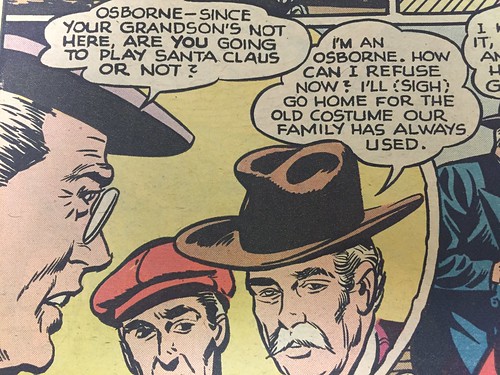
Oh, right. We can force the old guy with the missing grandson to ride on it and pretend to be Santa.
Superman is a horrible person.
Meanwhile, Lois is, shockingly enough, actually trying to help someone who isn't her or named after her:
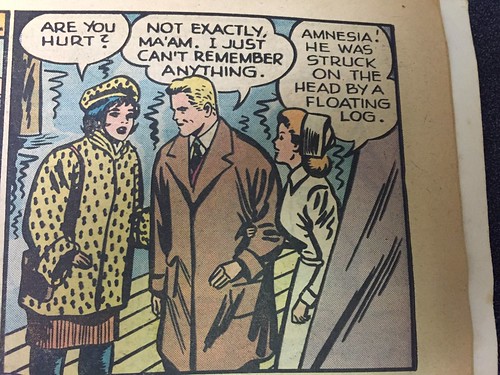
She wants to help that poor man with amnesia that she found in the water.

Or she wants to put him to work hefting sandbags. Seriously, Lois? If Superman wasn't busy playing a fiddling Nero over the drowned homes of Christmastown you'd be the worst person in this story, for making a man with neurological trauma and a head injury perform physical labor in wet, freezing conditions.

True. It's not like Superman's doing anything to stop the flooding, and morale at the levees seems pretty bad:
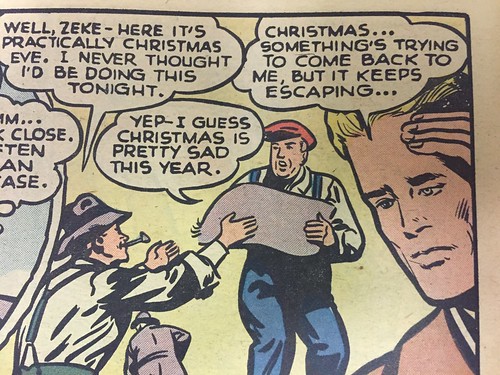
Worst Christmas ever. Too bad there's no superhero around to fix things, right? Wait, what's that coming in from upstream?

Yes, that's right, it's Superman's "Let Them Eat Cake While the Insurance Companies Deny Their Flood Damage Claims" party barge, complete with sad Santa:

Lois drags her amnesiac laborer over for a closer look, in pursuit of a better story, and somehow her relentless pursuit of a Pulitzer leads to a Christmas miracle:
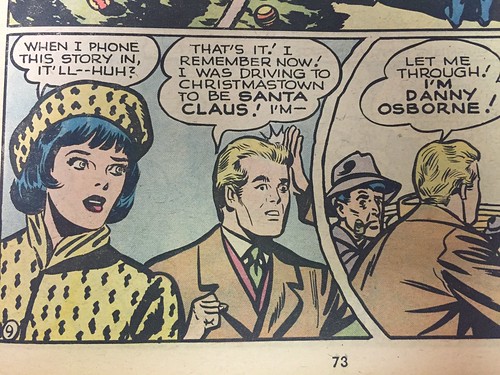
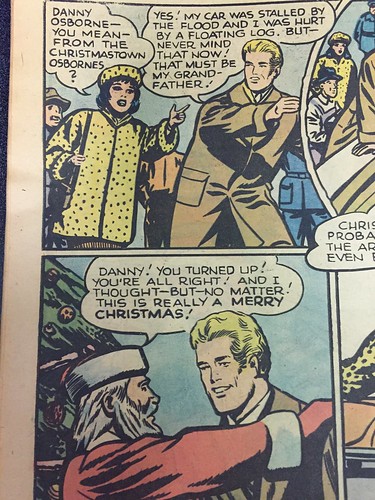
All that's left now is for Superman to redeem himself by taking care of the flooding, right? Look, there he goes, up into the sky:

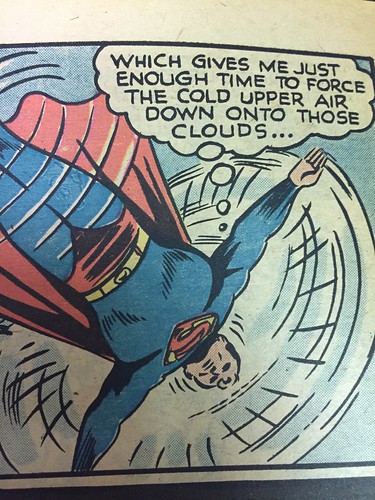
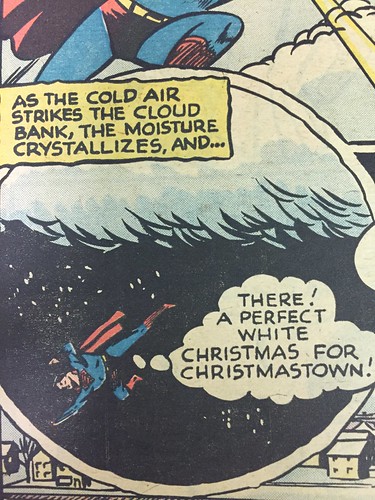
I'm not sure how things worked on Krypton, but here on Earth dropping a blizzard on top of heavy flooding isn't really a perfect Christmas.
Great job being a horrible person, Superman.

So, there you have it. A story of family, Christmas, and natural disaster that Lois didn't cause.
Merry Christmas, from all of us.
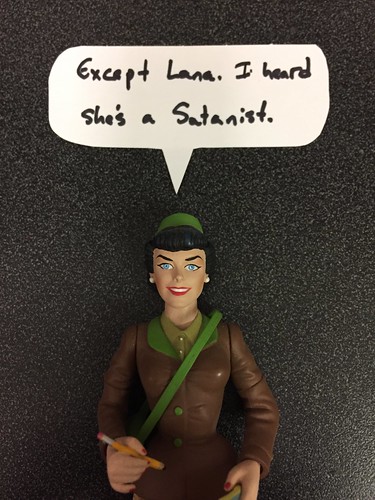

Sunday, December 6, 2015
Fudge, Fudge, And More Fudge
If you know me, you know that I have a holiday tradition of struggling with making fudge.
So many of my friends and family know about my struggle that right around Thanksgiving every year it starts becoming a topic of conversation. People will casually bring it up, giving me the side-eye to see if I will fly into a violent rage, or they might just come right out with it. My Uncle Mike, for example, gave me a piece (OK, I ate like five pieces) of fudge at Thanksgiving this year, and then handed me a printed out recipe. My friend Sharon presented me with the Carnation Famous Fudge Kit, a source of self-esteem damage, wailing, and gnashing of teeth in 2010, 2011, 2012, and 2013 (but not 2014, when I decided to try to follow a pair of fudge recipes instead), for my birthday this year, but my mom went ahead and made the fudge from it because I was afraid to bring it on an airplane after the TSA went into my checked suitcase and confiscated my shaving cream on my flight to New York.
As has happened often in past years, my mom casually followed the directions while feeding dogs, loading the dishwasher, and talking on the phone and still somehow produced delicious fudge just like on the box while explaining that it's so easy.
Lots of people tell me that fudge is easy.
So many people tell me this that I sometimes think, "I bet this is how Carrie felt at the prom," as I watch their stupid mouths move, but we're getting off topic. Back to the point, everyone I know can make fudge and I seem to have some sort of fudge problem.
I decided this year to make three kinds of fudge: the Famous Fudge Kit, the recipe that my Uncle Mike gave me, and Kraft's allegedly award-winning Velveeta Fudge recipe. Yes, that's right: I made fudge out of something that might be cheese. I am so desperate at this point to make creamy, delicious fudge that if someone told me the secret was clubbing baby seals to death while sobbing children watched, I would be online comparing prices on wooden clubs and plane tickets to rocky Canadian beaches by the end of the day. Compared to that, melting some fake half-cheese product barely registers on my mental radar.
Before I started, I decided to get myself in the mood by decorating the kitchen. In the same way that some cultures have a kitchen deity and a small shrine, I decided that I would summon the spirit of Christmas, and hung my most powerful Christmas talisman above the stove:
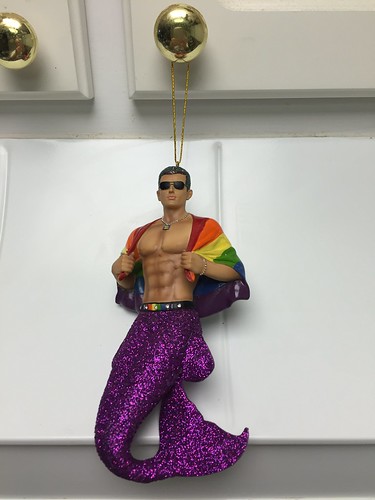
My homosexual sexy Christmas merman ornament. God bless us, every one, and God bless the fudge.
I started with Uncle Mike's Pumpkin Spice Fudge, which starts with four cups of white chocolate chips:
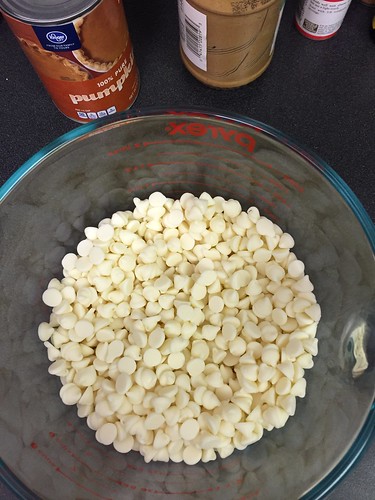
and some peanut butter:
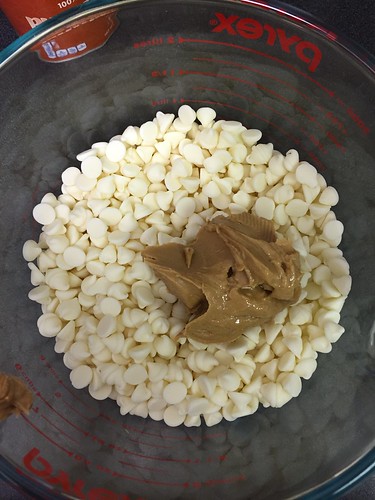
I think white chocolate is a vile shadow of real chocolate, but again, baby seals. I will try anything at this point. I microwaved the chips and peanut butter in short bursts, stirring often, and when it was fully blended:

I added the vanilla, pumpkin puree, cinnamon, and nutmeg. The recipe called for two teaspoons of pumpkin pie spice, but I couldn't find that at the grocery store (I probably missed it by about two weeks) so I used one teaspoon each of cinnamon and nutmeg. It looked a little browner than Uncle Mike's did, but I poured it into the dish:

put it in the refrigerator, and hoped for the best.
Then I moved on to the Velveeta Fudge, which starts with a lot of butter, light corn syrup, and some baker's chocolate:

And then the Velveeta comes in:
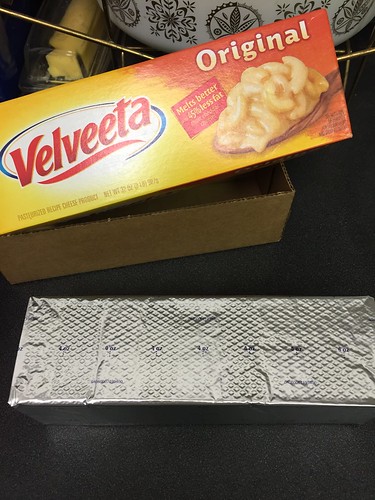
So much Velveeta. That gigantic brick of Velveeta was the smallest size block they had at Kroger, and now I have half a block of Velveeta in my refrigerator and no idea what to do with it because I usually only eat real cheese. Somewhere in my slow cooker book there are soup recipes that call for Velveeta, so maybe I can get rid of this that way. Anyway, I added the Velveeta:

and threw it in the microwave. I took it out halfway through cooking to stir, and immediately had grave reservations:

"What's the secret ingredient in your fudge?"
"The bile I accidentally threw up while leaning over a steaming bowl of fake cheese and chocolate bars."
I didn't really throw up, but that doesn't look anything like food that you would want to put in your mouth. Even scarier, this is a two bowl recipe. The other bowl, patiently waiting for the first one to finish in the microwave, contains 32 ounces of powdered sugar:

This must be what a Christmas buffet at Pablo Escobar's house looked like.
Once the first bowl seemed fully melted and blended, I poured it into the second bowl and started mixing. When I decided I was done, it looked a lot like fudge should look:

so I poured it into a baking dish and slid it into the refrigerator.
And then I came to the third fudge recipe:
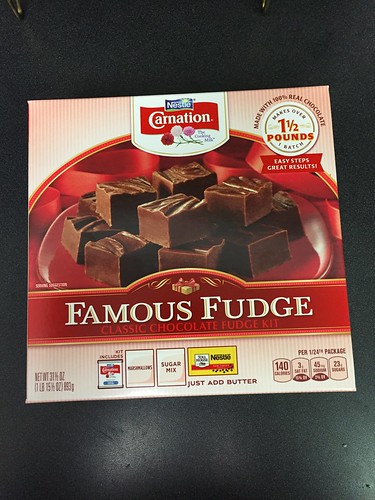
It wouldn't be Christmas without it.
I was slightly tired of fudge making at this point, and also thought about the way my mom approaches this kit, and decided to just do it, not think about it, and let the chocolate chips fall where they may. I assembled the parts:

heated and stirred until the marshmallows melted, and poured it into the baking dish:
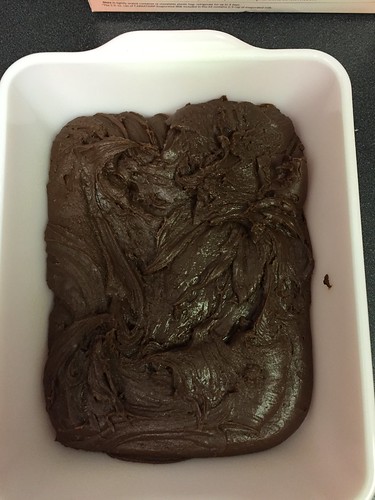
where it came out looking exactly like it has every other year.
I hate you, Carnation Famous Fudge Kit.
I hate you.
Hours later, the fudge was allegedly ready:
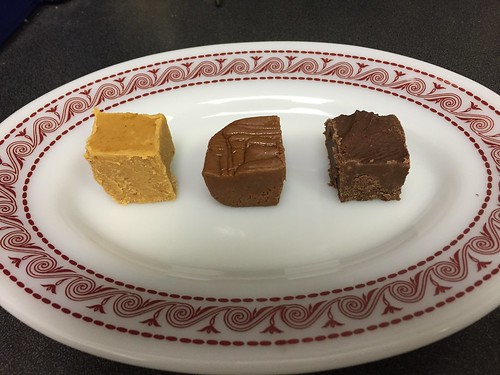
From left to right:
Uncle Mike's Pumpkin Spice Fudge: Delicious. Not too much pumpkin, not too much spice. The texture is nice, you can't taste the peanut butter at all, and it's a nice, tasty little bite. Or two. Or five. Shut up.
Kraft Velveeta Fudge: It's not bad. It's a little soft, and a little over sweet. I won't be making it again, but it may appeal to people who like their fudge a little sweeter than most chocolate fudge.
Carnation Famous Fudge Kit: The key, apparently, is to stop caring. It's firm, chocolatey, and not bad. This is the best that kit has ever come out for me.
The baby seals are safe, for now, and the office gets to snack their way through a ton of fudge this week.
So many of my friends and family know about my struggle that right around Thanksgiving every year it starts becoming a topic of conversation. People will casually bring it up, giving me the side-eye to see if I will fly into a violent rage, or they might just come right out with it. My Uncle Mike, for example, gave me a piece (OK, I ate like five pieces) of fudge at Thanksgiving this year, and then handed me a printed out recipe. My friend Sharon presented me with the Carnation Famous Fudge Kit, a source of self-esteem damage, wailing, and gnashing of teeth in 2010, 2011, 2012, and 2013 (but not 2014, when I decided to try to follow a pair of fudge recipes instead), for my birthday this year, but my mom went ahead and made the fudge from it because I was afraid to bring it on an airplane after the TSA went into my checked suitcase and confiscated my shaving cream on my flight to New York.
As has happened often in past years, my mom casually followed the directions while feeding dogs, loading the dishwasher, and talking on the phone and still somehow produced delicious fudge just like on the box while explaining that it's so easy.
Lots of people tell me that fudge is easy.
So many people tell me this that I sometimes think, "I bet this is how Carrie felt at the prom," as I watch their stupid mouths move, but we're getting off topic. Back to the point, everyone I know can make fudge and I seem to have some sort of fudge problem.
I decided this year to make three kinds of fudge: the Famous Fudge Kit, the recipe that my Uncle Mike gave me, and Kraft's allegedly award-winning Velveeta Fudge recipe. Yes, that's right: I made fudge out of something that might be cheese. I am so desperate at this point to make creamy, delicious fudge that if someone told me the secret was clubbing baby seals to death while sobbing children watched, I would be online comparing prices on wooden clubs and plane tickets to rocky Canadian beaches by the end of the day. Compared to that, melting some fake half-cheese product barely registers on my mental radar.
Before I started, I decided to get myself in the mood by decorating the kitchen. In the same way that some cultures have a kitchen deity and a small shrine, I decided that I would summon the spirit of Christmas, and hung my most powerful Christmas talisman above the stove:

My homosexual sexy Christmas merman ornament. God bless us, every one, and God bless the fudge.
I started with Uncle Mike's Pumpkin Spice Fudge, which starts with four cups of white chocolate chips:

and some peanut butter:

I think white chocolate is a vile shadow of real chocolate, but again, baby seals. I will try anything at this point. I microwaved the chips and peanut butter in short bursts, stirring often, and when it was fully blended:

I added the vanilla, pumpkin puree, cinnamon, and nutmeg. The recipe called for two teaspoons of pumpkin pie spice, but I couldn't find that at the grocery store (I probably missed it by about two weeks) so I used one teaspoon each of cinnamon and nutmeg. It looked a little browner than Uncle Mike's did, but I poured it into the dish:

put it in the refrigerator, and hoped for the best.
Then I moved on to the Velveeta Fudge, which starts with a lot of butter, light corn syrup, and some baker's chocolate:

And then the Velveeta comes in:

So much Velveeta. That gigantic brick of Velveeta was the smallest size block they had at Kroger, and now I have half a block of Velveeta in my refrigerator and no idea what to do with it because I usually only eat real cheese. Somewhere in my slow cooker book there are soup recipes that call for Velveeta, so maybe I can get rid of this that way. Anyway, I added the Velveeta:

and threw it in the microwave. I took it out halfway through cooking to stir, and immediately had grave reservations:

"What's the secret ingredient in your fudge?"
"The bile I accidentally threw up while leaning over a steaming bowl of fake cheese and chocolate bars."
I didn't really throw up, but that doesn't look anything like food that you would want to put in your mouth. Even scarier, this is a two bowl recipe. The other bowl, patiently waiting for the first one to finish in the microwave, contains 32 ounces of powdered sugar:

This must be what a Christmas buffet at Pablo Escobar's house looked like.
Once the first bowl seemed fully melted and blended, I poured it into the second bowl and started mixing. When I decided I was done, it looked a lot like fudge should look:

so I poured it into a baking dish and slid it into the refrigerator.
And then I came to the third fudge recipe:

It wouldn't be Christmas without it.
I was slightly tired of fudge making at this point, and also thought about the way my mom approaches this kit, and decided to just do it, not think about it, and let the chocolate chips fall where they may. I assembled the parts:

heated and stirred until the marshmallows melted, and poured it into the baking dish:

where it came out looking exactly like it has every other year.
I hate you, Carnation Famous Fudge Kit.
I hate you.
Hours later, the fudge was allegedly ready:

From left to right:
Uncle Mike's Pumpkin Spice Fudge: Delicious. Not too much pumpkin, not too much spice. The texture is nice, you can't taste the peanut butter at all, and it's a nice, tasty little bite. Or two. Or five. Shut up.
Kraft Velveeta Fudge: It's not bad. It's a little soft, and a little over sweet. I won't be making it again, but it may appeal to people who like their fudge a little sweeter than most chocolate fudge.
Carnation Famous Fudge Kit: The key, apparently, is to stop caring. It's firm, chocolatey, and not bad. This is the best that kit has ever come out for me.
The baby seals are safe, for now, and the office gets to snack their way through a ton of fudge this week.
Tuesday, December 1, 2015
The Month in Books: November
Since I had a vacation during November, which I am on the last day of right now (Farewell, vacation! You may be gone, but I promise to think wistfully of you throughout the next week, sighing heavily and swooning to my fainting couch in grief.) I read a few more books than usual. My vacation books had a theme, but before I could get to them I read a few other things and I had to finish October's Vampire Madness.
Yes, that's right: I had to finish the last insane book in Christopher Pike's insane The Last Vampire series, which Wikipedia has just informed me may not be the final book after all. Will I descend once more in Vampire Madness? Sure, why not? I've already read this far.
1) The story of Sita, the Last Vampire, reaches a frenzied conclusion in Christopher Pike's Thirst 5: The Sacred Veil. Having foiled the IIC and the immortal Telar, Sita and her friends now find themselves on the run from the federal government due to a malevolent computer program unleashed by the IIC at the moment of defeat that has made them the top five people on the FBI's most wanted list. They're also pursued by all of the leftover plot threads from the previous four books, including the aliens from Book 2, Lucifer, time travel, and the surprise addition of Nazis! Yes, somehow their current troubles are linked to the time that Sita fought Himmler for Veronica's Veil just before the invasion at Normandy, and now Sita struggles to remember her repressed memories of that period while trying to stay one step ahead of her time traveling foes. At the same time, she also struggles with her feelings for Sexy Matt, now that she's returned to her own body and Teri and Teri's body are dead and out of the way. Can Sita and her friends survive this latest struggle for their lives? And can Sita help Patton, who is also the reincarnation of Ulysses S. Grant, invade Europe while Rommel's out of town? And why can't she remember? And will she use time travel to erase herself and all the other vampires from history again, and actually mean it this time, or will a last minute sexy intervention by a time traveling Sexy Matt be enough to stop her?
This was just as crazy as the previous books, in case the summary didn't make that clear. Are these good books? Not really, but they're entertaining like watching a dumb movie with lots of explosions is entertaining.
2) Elliot James' Charming introduces John Charming, the latest in a line of monster hunters and creature slayers, protecting humanity from all manner of terrible things as part of an order of knights. Now on the run from his order due to a supernatural curse, John is trying to lay low and stay off the radar, but the vampire and Valkyrie who walk into his bar have other ideas. This was ok, and somewhat entertaining, but not engaging enough to make me want to pick up the sequels.
3) When I said I was done with Douglas Coupland, many of my friends said, "What about Microserfs? It was such a good book. I just love Microserfs."
I do not love Microserfs.
It was long, tedious, and painful to force myself through. It also seemed pretty dated. I don't mean in the sense that the technology and pop culture references are dated, but more that the whole tone of the book seemed very specific to when it was written. When I mentioned this to my friend Jackie, her response was, "Jane Eyre? So dated. What's Rochester doing riding a horse? People drive cars now," but the difference, for me, is that the themes and characters and feelings in a book like that transcend the time in which it was written, and Microserfs, to me, doesn't do that. I could be wrong about this book, and it could be wonderful and relevant and well worth reading, but it did not seem so to me.
4) Gillian Flynn's The Grownup is a short story published as a book. Charitably, I guess you could call it a novella, but it may not be quite long enough for that. Regardless, this story of a former prostitute turned fake psychic trying to con her way to a good score was entertaining and much less depressing than any of her full length novels. The unnamed narrator sees Susan, an unhappy housewife who has some sort of spiritual trouble at home, as her chance to move up to higher class clients, offering to cleanse the dark spirits from Susan's house and spooky stepson in hopes that Susan will refer her to her rich friends, but as the story unfolds it quickly becomes a question of who, exactly, is conning whom? I enjoyed it, but again, this is very short and probably not worth the price for the length.
5) Jake is The Last Werewolf in Glen Duncan's novel, and he's ready to die. Almost 200, hunted for decades by a secret paramilitary organization, tired of fighting with vampires, and jaded from outliving all of his friends, Jake is ready to surrender to Grainer, the hunter whose father Jake killed a few decades ago. On his way to the forest clearing where he was created, watched from a distance by agents of Grainer's organization and the vampire families, Jake encounters the unthinkable: a living, breathing, female werewolf. In one minute, everything changes, and now Jake has to figure out how to keep them both alive and how to get them out of the final, noble death he'd arranged for himself.
This was sort of interesting, and the author tried really hard to characterize the werewolf as an animalistic, pragmatic human obsessed with eating and sex, but I'm not sure the best way to do that is to describe every woman in the book's vagina as a warm cunt, over and over and over, to the point that I wonder how someone lives to be 200 years old and never picks up any other vocabulary.
Right after that book, I started my vacation, and pulled a bunch of comic-related books from my stacks to read.
6) Grant Morrison's Supergods was an interesting discussion of the history of comic books, the social impact on pop culture, and a semi-autobiography of Morrison himself. While I could have done with a little less of Morrison's consciousness-expanding personal journeys (there's a stretch about 2/3 of the way through when he's having an out of body experience with neon gas beings who are showing him the superstructure of the universe where I was thinking, "Are we getting back to comics soon? Please?") I did pick out three really interesting points:
a) Morrison talks about how the cultural explosion and immense profitability of characters like Superman and Batman were copied and reflected overseas. This is the first comic history I've read that talks about how the UK, Italy, France, Japan, etc. took the idea of the superhero and made it their own. This discussion also ties into the second point.
b) I didn't realize that Fantomex, one of Morrison's additions to the X-Men cast when he wrote that book, was a direct homage to the French and Italian characters Fantomas and Diabolik.

Mais oui, Fantomex. Morrison doesn't come right out and say it in this book, but while describing those characters, who started out as Batman clones, it's pretty clear how many of their plot and costuming elements translated into Fantomex, right down to the name. When Wolverine tells Fantomex in "Uncanny X-Force" that there's nothing about him that's all that original:
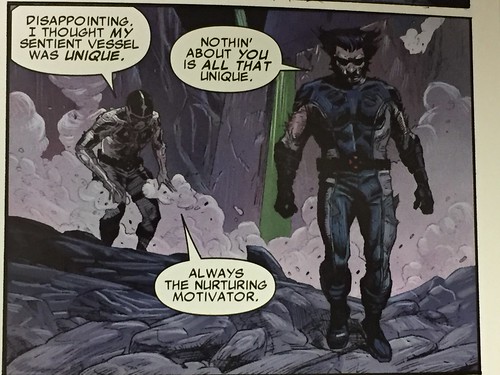
he was way more accurate than I realized at the time.
c) Morrison points out how canny Lee, McFarlane, and Liefeld were in naming their new comics when they split off from DC and Marvel to found Image comics in the 90's. In what is either a shocking coincidence or a strategy to place themselves next to the books that made them famous on the alphabetic new release racks at comic stores, those three went from working on "Uncanny X-Men", "Spider-Man", and "X-Force" to writing and publishing "Wildcats", "Spawn", and "Youngblood". The proximity to their old titles meant that their fans didn't have to look very far to see their new stuff. Whether or not it was on purpose, it's pretty funny when Morrison points it out.
7) Mark Evanier's Kirby: King of Comics is a biography of Jack Kirby, co-creator of the Mighty Thor, the Incredible Hulk, the X-Men, Spider-Man, Darkseid and the New Gods, the Challengers of the Unknown, the Fantastic Four, and a bunch of other creations that he didn't get a lot of payment for even though he eventually got the recognition. While Stan Lee tells a very different story of the co-creations on the Marvel side, this book takes Kirby's side pretty strongly, asserting that he did a lot of work that other people put their names on and that he was cheated out of a lot of royalties. Outside of that, this book is filled with gorgeous examples of Kirby's art, but is also a fast read.
8) The Empire State is a fog shrouded island where Prohibition keeps the nightlife under control, the citizens live under rationing because of the constant state of Wartime with an unseen enemy somewhere beyond the fog, giant steel ironclads are constructed and sent with the robot armies through the fog to war, and the Empire State's City Council rules from an unseen boardroom high above the city in the Empire State Building, the tallest structure on the island. Rad Bradley, a private detective, stumbles through the streets of the Empire State, combing the island for clues to the mysterious disappearance of Sam Saturn, a missing young woman. Finding her will be more than Rad bargained for, though, because Sam is dead, killed by Rad's double, a very different man from a mysterious city called New York, and the answer to the mystery of how and why that's possible could mean the end of the Empire State and New York City and everyone living there. Adam Christopher tried to make this tale of parallel universes overlapping each other interesting, and at some points it was, but for the most part it was choppy, didn't follow its own rules about travel between universes, and one character double crossed the rest so many times I wasn't sure why he did anything at any point in the story. Despite all of that, though, I still put the sequel on my amazon wish list, as there seemed to be some possibility there that maybe didn't quite carry over in the execution.
9) I've had Mary Jane 2 sitting in my book pile for a while, even though I read the first book a few years ago. This one picks up where the last one left off, continuing Mary Jane Watson's adventures in high school as she fights self esteem issues, contemplates dropping out of ballet, wonders if her boyfriend Peter could maybe possibly be that new superhero, Spider-Man, and worries that Peter will break up with her for the much hotter Gwen Stacy, who has an obvious crush on him for some reason. It's not bad, but not really all that exciting. I'm guessing the target market felt the same way, since there isn't a third book.
10) Sean Howe's Marvel Comics: The Untold Story was a lot more fair regarding the debate over whether Kirby or Lee created most of Marvel's icons than I'd heard it was. It doesn't give either of them full credit and makes it very clear that their accounts differ, that a lot of other creators and workers at Marvel at the time side with Kirby, and that there is unfortunately no proof at this point and no way to definitively settle the issue. The book also doesn't dwell on it and moves on to other things, such as Marvel's history of corporate buyouts and ownership shuffles, near bankruptcies, and ultimate success. There's a lot of information here that a lot of comic fans will really enjoy, like the reaction to Alpha Flight's creator sneaking Northstar's coming out under editorial radar and the reaction to it, the reason why the New Universe experiment happened at all, the creator of Howard the Duck's lifelong battle with the company over the rights, redesigning the Black Panther's costume not to show any of his non-white skin so that newsstands in the south would still sell comics with him on the cover, and a lot of other Marvel trivia that I really enjoyed but that a non-fan would probably find a little boring to sift through. If you're coming at this as a person who has really enjoyed the last ten or so Marvel movies and wants to learn more about the company, this will probably be a little dense and ultimately not that exciting.
Moving into December, I'm in the home stretch as far as reading goes. How many books will I finish this year?
We'll know in thirty days.
Yes, that's right: I had to finish the last insane book in Christopher Pike's insane The Last Vampire series, which Wikipedia has just informed me may not be the final book after all. Will I descend once more in Vampire Madness? Sure, why not? I've already read this far.
1) The story of Sita, the Last Vampire, reaches a frenzied conclusion in Christopher Pike's Thirst 5: The Sacred Veil. Having foiled the IIC and the immortal Telar, Sita and her friends now find themselves on the run from the federal government due to a malevolent computer program unleashed by the IIC at the moment of defeat that has made them the top five people on the FBI's most wanted list. They're also pursued by all of the leftover plot threads from the previous four books, including the aliens from Book 2, Lucifer, time travel, and the surprise addition of Nazis! Yes, somehow their current troubles are linked to the time that Sita fought Himmler for Veronica's Veil just before the invasion at Normandy, and now Sita struggles to remember her repressed memories of that period while trying to stay one step ahead of her time traveling foes. At the same time, she also struggles with her feelings for Sexy Matt, now that she's returned to her own body and Teri and Teri's body are dead and out of the way. Can Sita and her friends survive this latest struggle for their lives? And can Sita help Patton, who is also the reincarnation of Ulysses S. Grant, invade Europe while Rommel's out of town? And why can't she remember? And will she use time travel to erase herself and all the other vampires from history again, and actually mean it this time, or will a last minute sexy intervention by a time traveling Sexy Matt be enough to stop her?
This was just as crazy as the previous books, in case the summary didn't make that clear. Are these good books? Not really, but they're entertaining like watching a dumb movie with lots of explosions is entertaining.
2) Elliot James' Charming introduces John Charming, the latest in a line of monster hunters and creature slayers, protecting humanity from all manner of terrible things as part of an order of knights. Now on the run from his order due to a supernatural curse, John is trying to lay low and stay off the radar, but the vampire and Valkyrie who walk into his bar have other ideas. This was ok, and somewhat entertaining, but not engaging enough to make me want to pick up the sequels.
3) When I said I was done with Douglas Coupland, many of my friends said, "What about Microserfs? It was such a good book. I just love Microserfs."
I do not love Microserfs.
It was long, tedious, and painful to force myself through. It also seemed pretty dated. I don't mean in the sense that the technology and pop culture references are dated, but more that the whole tone of the book seemed very specific to when it was written. When I mentioned this to my friend Jackie, her response was, "Jane Eyre? So dated. What's Rochester doing riding a horse? People drive cars now," but the difference, for me, is that the themes and characters and feelings in a book like that transcend the time in which it was written, and Microserfs, to me, doesn't do that. I could be wrong about this book, and it could be wonderful and relevant and well worth reading, but it did not seem so to me.
4) Gillian Flynn's The Grownup is a short story published as a book. Charitably, I guess you could call it a novella, but it may not be quite long enough for that. Regardless, this story of a former prostitute turned fake psychic trying to con her way to a good score was entertaining and much less depressing than any of her full length novels. The unnamed narrator sees Susan, an unhappy housewife who has some sort of spiritual trouble at home, as her chance to move up to higher class clients, offering to cleanse the dark spirits from Susan's house and spooky stepson in hopes that Susan will refer her to her rich friends, but as the story unfolds it quickly becomes a question of who, exactly, is conning whom? I enjoyed it, but again, this is very short and probably not worth the price for the length.
5) Jake is The Last Werewolf in Glen Duncan's novel, and he's ready to die. Almost 200, hunted for decades by a secret paramilitary organization, tired of fighting with vampires, and jaded from outliving all of his friends, Jake is ready to surrender to Grainer, the hunter whose father Jake killed a few decades ago. On his way to the forest clearing where he was created, watched from a distance by agents of Grainer's organization and the vampire families, Jake encounters the unthinkable: a living, breathing, female werewolf. In one minute, everything changes, and now Jake has to figure out how to keep them both alive and how to get them out of the final, noble death he'd arranged for himself.
This was sort of interesting, and the author tried really hard to characterize the werewolf as an animalistic, pragmatic human obsessed with eating and sex, but I'm not sure the best way to do that is to describe every woman in the book's vagina as a warm cunt, over and over and over, to the point that I wonder how someone lives to be 200 years old and never picks up any other vocabulary.
Right after that book, I started my vacation, and pulled a bunch of comic-related books from my stacks to read.
6) Grant Morrison's Supergods was an interesting discussion of the history of comic books, the social impact on pop culture, and a semi-autobiography of Morrison himself. While I could have done with a little less of Morrison's consciousness-expanding personal journeys (there's a stretch about 2/3 of the way through when he's having an out of body experience with neon gas beings who are showing him the superstructure of the universe where I was thinking, "Are we getting back to comics soon? Please?") I did pick out three really interesting points:
a) Morrison talks about how the cultural explosion and immense profitability of characters like Superman and Batman were copied and reflected overseas. This is the first comic history I've read that talks about how the UK, Italy, France, Japan, etc. took the idea of the superhero and made it their own. This discussion also ties into the second point.
b) I didn't realize that Fantomex, one of Morrison's additions to the X-Men cast when he wrote that book, was a direct homage to the French and Italian characters Fantomas and Diabolik.

Mais oui, Fantomex. Morrison doesn't come right out and say it in this book, but while describing those characters, who started out as Batman clones, it's pretty clear how many of their plot and costuming elements translated into Fantomex, right down to the name. When Wolverine tells Fantomex in "Uncanny X-Force" that there's nothing about him that's all that original:

he was way more accurate than I realized at the time.
c) Morrison points out how canny Lee, McFarlane, and Liefeld were in naming their new comics when they split off from DC and Marvel to found Image comics in the 90's. In what is either a shocking coincidence or a strategy to place themselves next to the books that made them famous on the alphabetic new release racks at comic stores, those three went from working on "Uncanny X-Men", "Spider-Man", and "X-Force" to writing and publishing "Wildcats", "Spawn", and "Youngblood". The proximity to their old titles meant that their fans didn't have to look very far to see their new stuff. Whether or not it was on purpose, it's pretty funny when Morrison points it out.
7) Mark Evanier's Kirby: King of Comics is a biography of Jack Kirby, co-creator of the Mighty Thor, the Incredible Hulk, the X-Men, Spider-Man, Darkseid and the New Gods, the Challengers of the Unknown, the Fantastic Four, and a bunch of other creations that he didn't get a lot of payment for even though he eventually got the recognition. While Stan Lee tells a very different story of the co-creations on the Marvel side, this book takes Kirby's side pretty strongly, asserting that he did a lot of work that other people put their names on and that he was cheated out of a lot of royalties. Outside of that, this book is filled with gorgeous examples of Kirby's art, but is also a fast read.
8) The Empire State is a fog shrouded island where Prohibition keeps the nightlife under control, the citizens live under rationing because of the constant state of Wartime with an unseen enemy somewhere beyond the fog, giant steel ironclads are constructed and sent with the robot armies through the fog to war, and the Empire State's City Council rules from an unseen boardroom high above the city in the Empire State Building, the tallest structure on the island. Rad Bradley, a private detective, stumbles through the streets of the Empire State, combing the island for clues to the mysterious disappearance of Sam Saturn, a missing young woman. Finding her will be more than Rad bargained for, though, because Sam is dead, killed by Rad's double, a very different man from a mysterious city called New York, and the answer to the mystery of how and why that's possible could mean the end of the Empire State and New York City and everyone living there. Adam Christopher tried to make this tale of parallel universes overlapping each other interesting, and at some points it was, but for the most part it was choppy, didn't follow its own rules about travel between universes, and one character double crossed the rest so many times I wasn't sure why he did anything at any point in the story. Despite all of that, though, I still put the sequel on my amazon wish list, as there seemed to be some possibility there that maybe didn't quite carry over in the execution.
9) I've had Mary Jane 2 sitting in my book pile for a while, even though I read the first book a few years ago. This one picks up where the last one left off, continuing Mary Jane Watson's adventures in high school as she fights self esteem issues, contemplates dropping out of ballet, wonders if her boyfriend Peter could maybe possibly be that new superhero, Spider-Man, and worries that Peter will break up with her for the much hotter Gwen Stacy, who has an obvious crush on him for some reason. It's not bad, but not really all that exciting. I'm guessing the target market felt the same way, since there isn't a third book.
10) Sean Howe's Marvel Comics: The Untold Story was a lot more fair regarding the debate over whether Kirby or Lee created most of Marvel's icons than I'd heard it was. It doesn't give either of them full credit and makes it very clear that their accounts differ, that a lot of other creators and workers at Marvel at the time side with Kirby, and that there is unfortunately no proof at this point and no way to definitively settle the issue. The book also doesn't dwell on it and moves on to other things, such as Marvel's history of corporate buyouts and ownership shuffles, near bankruptcies, and ultimate success. There's a lot of information here that a lot of comic fans will really enjoy, like the reaction to Alpha Flight's creator sneaking Northstar's coming out under editorial radar and the reaction to it, the reason why the New Universe experiment happened at all, the creator of Howard the Duck's lifelong battle with the company over the rights, redesigning the Black Panther's costume not to show any of his non-white skin so that newsstands in the south would still sell comics with him on the cover, and a lot of other Marvel trivia that I really enjoyed but that a non-fan would probably find a little boring to sift through. If you're coming at this as a person who has really enjoyed the last ten or so Marvel movies and wants to learn more about the company, this will probably be a little dense and ultimately not that exciting.
Moving into December, I'm in the home stretch as far as reading goes. How many books will I finish this year?
We'll know in thirty days.
Subscribe to:
Comments (Atom)